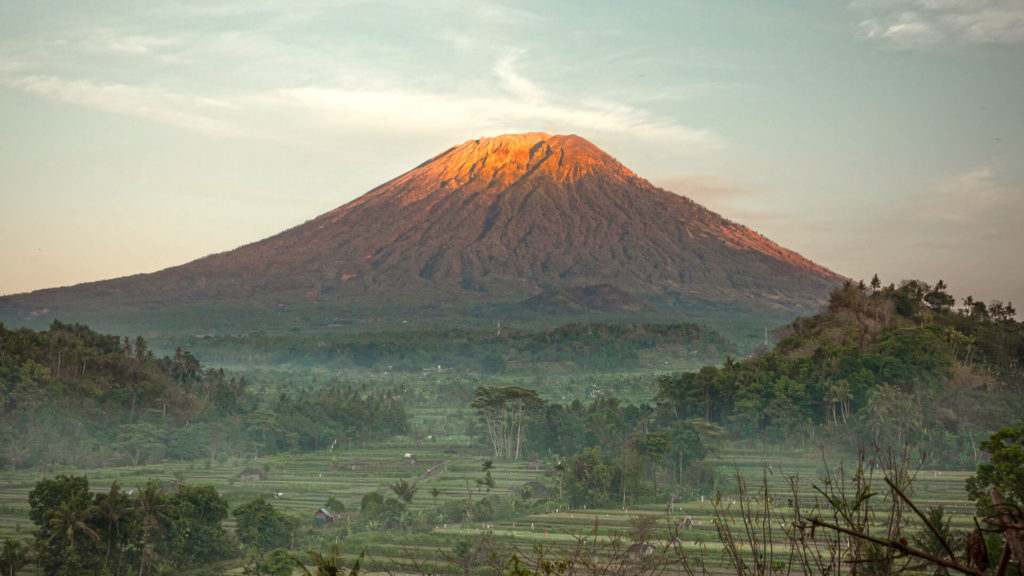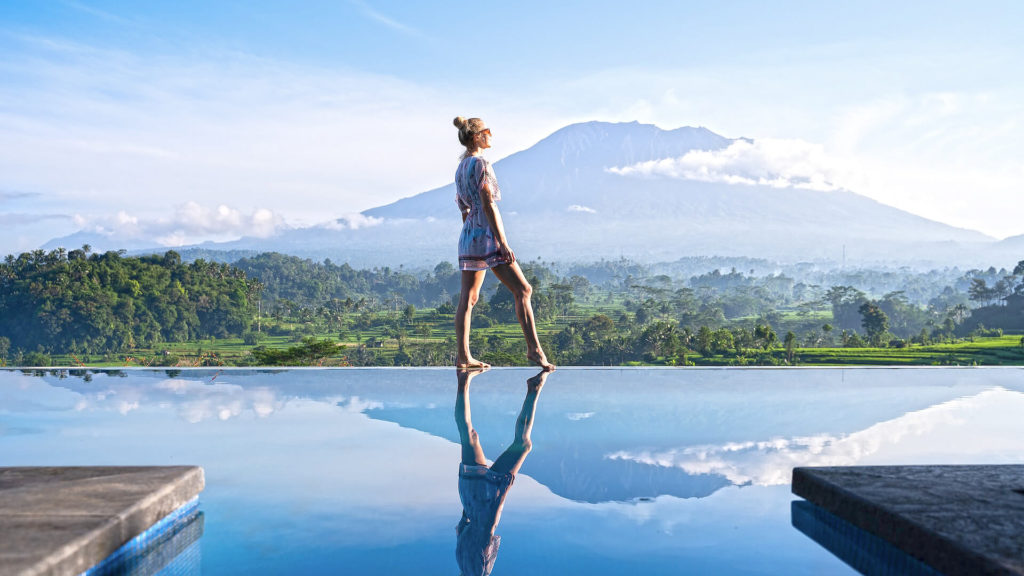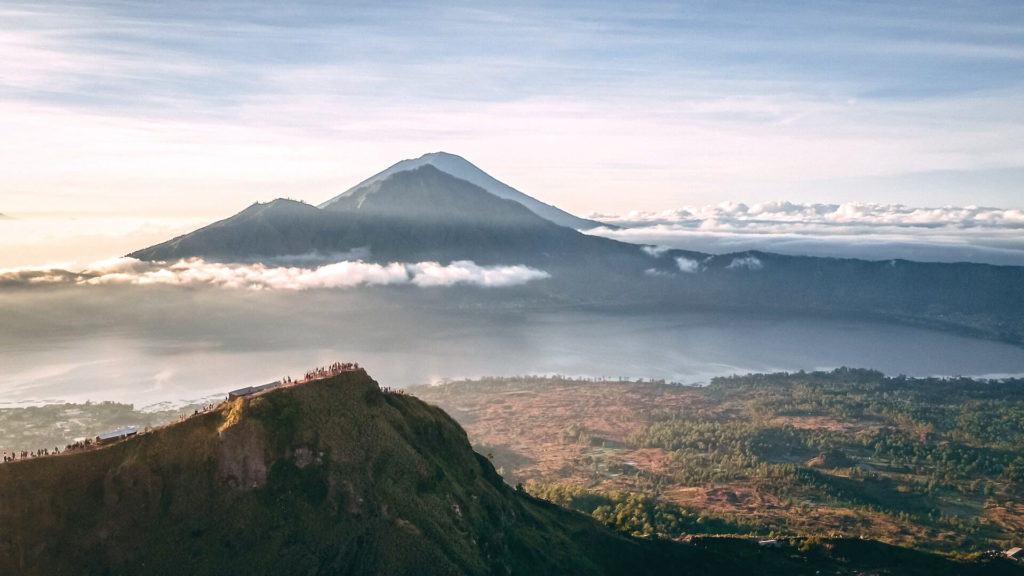Volcanoes of Bali

Table of Contents
Mount Agung: The Sacred Giant

Geologically classified as an active stratovolcano, Mount Agung has played a significant role in the island’s history. It has experienced several eruptions throughout the years, with the most notable one occurring in 1963, causing widespread devastation. Despite its destructive power, the eruption spared the revered Besakih Temple, located on the southern side of the volcano, reinforcing the spiritual significance attributed to the event by the Balinese people.
Today, Mount Agung continues to awe and inspire with its majestic presence. It is considered the most sacred mountain in Bali and is an important pilgrimage site for the Balinese Hindu community. As we explore further, we will delve into the hiking opportunities and accommodations near this magnificent volcano.
- Elevation: 3,031 m
- Last eruption: June 13, 2019
- Prominence: 3,031 m
- Province: Bali
- Coordinates: 8°20′27″S 115°30′12″E / 8.34083°S 115.50333°E
- English translation: Paramount, The Great Mountain
- Isolation: 105 km (65 mi)
Geology and Historical Eruptions
Mount Agung has a tumultuous history of eruptions, with the most devastating one occurring in 1963. This eruption, coinciding with the once-a-century religious ceremonies at the Besakih Temple, caused widespread destruction and loss of life. Since then, the volcano has remained relatively dormant, with occasional volcanic activity observed.
The Spiritual Significance of Mount Agung
According to Balinese Hindu beliefs, Mount Agung holds great spiritual importance. It is home to the revered Besakih Temple, the largest and holiest temple on the island. Pilgrims and devotees from all over Bali gather here to pay homage to their deities and seek blessings. The temple’s location against the backdrop of the majestic Mount Agung adds to its ethereal beauty and tranquility.
Hiking Mount Agung: A Challenge Worth Pursuing
For adventure seekers and hiking enthusiasts, conquering Mount Agung is a thrilling endeavor. The sunrise trek to its summit is a popular attraction, offering breathtaking views and a sense of accomplishment. However, it is important to note that hiking Mount Agung is not for the faint of heart. The steep and challenging trails require physical fitness and stamina.
The trek to the summit of Mount Agung typically takes around 6 hours, leading through tropical jungles and rocky pathways. As you ascend, the lush vegetation gives way to panoramic views of the island, including the tip of Mount Agung itself. It is a truly awe-inspiring experience that rewards hikers with a sense of accomplishment and the opportunity to witness the beauty of Bali from a higher perspective.
Where to Stay Near Mount Agung: Embracing Nature’s Majesty
After a challenging hike, finding a comfortable place to rest and rejuvenate is essential. While there are no accommodations on the volcano itself, there are several options in the surrounding area that offer stunning views and a tranquil atmosphere.
One such place is Palmterrace, a private apartment with a pool overlooking expansive jungle views and the distant Mount Agung. It provides a comfortable and relaxing getaway in the heart of Karangasem. Another option is Jero Tumbuk, a beautiful treehouse-style accommodation nestled in a lush jungle garden. Its serene setting allows guests to reconnect with nature and unwind after their mountain adventure. For those seeking luxury, there are villas like Villa Agung, which offer intimate and private retreats with stunning views of Mount Agung.
Mount Batur: A Majestic Hike and Scenic Beauty

Volcanic Activity and Historical Eruptions
Mount Batur is known for its frequent volcanic activity, with over 20 eruptions recorded in the past two centuries. The most significant eruptions occurred in 1917, 1926, and 1963, coinciding with the eruption of Mount Agung. These eruptions have shaped the landscape of the surrounding area and have contributed to the fertility of the volcanic soil.
Sunrise Trekking and Stunning Views
One of the most popular activities at Mount Batur is the sunrise trek, which offers visitors a chance to witness the first rays of dawn illuminating the picturesque landscapes. The relatively moderate difficulty level of the trek makes it accessible to a wide range of travelers, and the breathtaking views from the summit make every step worth it. The tranquil Lake Batur, located adjacent to the volcano, adds to the scenic beauty of the area.
Hiking Mount Batur: Witnessing the Magic of Sunrise
The Mount Batur sunrise trek is a must-do experience for any visitor to Bali. Starting in the early morning, an expert guide will lead you up the rocky trail to the summit, where you will be greeted with breathtaking sunrise views. The ascent is considered of medium difficulty, making it suitable for hikers with a reasonable level of fitness.
As you reach the summit, the golden rays of the rising sun illuminate the surrounding landscape, revealing the stunning beauty of Bali’s mountains and lakes. It is truly a magical moment that will stay with you long after the hike is complete.
Where to Stay Near Mount Batur: Unforgettable Views and Tranquility
To fully immerse yourself in the beauty of Mount Batur, there are several accommodations available in the area that offer unbeatable views and a serene atmosphere. Batur Exotic Villa is a great option, providing a unique experience with its eco-friendly accommodation and close proximity to the volcano. Sari Restaurant and The Amora Bali are also excellent choices, offering delicious meals with panoramic views of Mount Batur.
Mount Batukaru (Tabanan)
Mount Batukaru, the second tallest peak in Bali (2,276 meters), is a hidden gem located in the southern part of Pohen Mountain. This mountain boasts the last true section of jungle in Bali, providing a unique and pristine environment for exploration. Hiking to the peak of Mount Batukaru offers a spectacular 360-degree view of the entire island, allowing visitors to appreciate Bali’s beauty in its entirety.
On the edge of Mount Batukaru lies the magnificent Pura Luhur Batukaru, one of the six main temples in Bali, known as Sad Kahyangan. This temple attracts thousands of worshippers during Hindu ceremonies, as Balinese people from all corners of the island gather here. The temple’s surroundings are untouched and offer a spiritual sanctuary for visitors.
Located in the northern area of Tabanan, approximately three hours’ drive from Denpasar, Mount Batukaru is a must-visit destination for those seeking a profound connection with nature and spirituality.
Mount Abang
Mount Abang, also known as Mount Red, is hidden on the eastern side of Lake Batur, Mount Abang offers sweeping views of the surrounding landscape.Formerly part of Mount Batur, it split off after a massive eruption, leaving behind a vast caldera. While Mount Abang is not as commonly visited as its famous sibling, it provides a less crowded and more intimate hiking experience
The mountain is adorned with beautiful flowers of various colors, creating a vibrant and picturesque setting. Climbing Mount Abang is recommended during daylight hours to avoid the searing sunlight, as shade is limited along the way.
The peak of Mount Abang is home to several ancient temples, including Pura Munggu, Pura Manu Kaya, and Pura Puncak Tuluk Biu. These temples add a touch of history and spirituality to the mountain’s allure. Located in the sub-district of Kintamani, Bangli, Mount Abang can be reached via Penelokan, a scenic route that offers breathtaking views of the crater rim.
Mt. Catur
Mount Catur, standing side-by-side with Pohen Mountain, is a paradise for nature enthusiasts and those seeking adventure. Like Pohen Mountain, it offers a breathtaking view of Lake Beratan, adding to the allure of this scenic spot. Visitors to Mount Catur must bring their own food and water, as no tourism facilities are available here.
Located in the sub-district of Baturiti, Tabanan, Mount Catur is approximately a two-hour drive from Denpasar. The northern side of the peak is home to the popular Gitgit Waterfall, providing an additional attraction for those exploring the area. On the southern bank of Lake Beratan and in Candi Kuning, visitors can find various tourist facilities to enhance their experience.
Seraya Mountain
Seraya Mountain, situated on the edge of Lake Buyan, offers a unique blend of natural beauty and cultural heritage. Opposite the mountain’s slope lies Tirta Gangga, a 1930s water park built by Prince Anak Agung Anglurah Ketut Karangasem, a respected statesman and architect. The park’s temple features a spring believed to possess healing properties, allowing visitors to submerge or swim in its revitalizing waters.
Located in the sub-district of Abang, Karangasem, Seraya Mountain is approximately 17 km from the capital city, Amlapura. Visitors can enjoy accommodations, restaurants, and souvenir shops in the vicinity, ensuring a comfortable and memorable experience.
Mt. Lempuyang
Mount Lempuyang, Bali’s easternmost peak, is shrouded in dense forests inhabited by monkeys and various bird species. This mountain holds great significance for Balinese Hindus, who embark on regular pilgrimages to the temple at its summit. The temple, accessible via 1,174 stairs, is considered a must-visit for every Balinese Hindu, representing an important spiritual journey.
Located northeast of the capital city, Amlapura, Mount Lempuyang offers only traditional accommodations and shops to maintain the sanctity of the temple. Visitors can immerse themselves in the spiritual atmosphere and witness the devotion of the local community.
FAQs
What is the highest volcano in Bali?
Mount Agung is the highest volcano in Bali, reaching an elevation of approximately 3,031 meters (9,944 feet).
When was the last eruption of Bali's volcanoes?
The most recent significant eruption was from Mount Agung, which occurred intermittently from 2017 to 2019.
Can you visit the volcanoes in Bali?
Yes, you can visit both Mount Batur and Mount Agung. Mount Batur is a popular location for sunrise treks. Visits to Mount Agung, however, depend on current volcanic activity and advisories from the local government and volcanology center.
Is it safe to climb the volcanoes in Bali?
Climbing Bali's volcanoes can be safe with proper precautions. This includes being in good physical health, using a local guide, having suitable equipment, and checking up-to-date information on volcanic activity. Safety cannot be guaranteed due to the active status of these volcanoes, and travel advisories should be monitored.
Are the volcanoes in Bali part of the Pacific Ring of Fire?
Yes, the volcanoes in Bali are part of the Pacific Ring of Fire, an area with frequent earthquakes and volcanic eruptions encircling the basin of the Pacific Ocean.
What impact do the volcanoes have on Bali's environment?
The volcanoes in Bali have significantly shaped the island's environment and ecosystem. Volcanic soil is highly fertile, supporting agriculture, including the cultivation of rice in terraced fields. However, eruptions pose risks to local communities and can disrupt tourism, a major part of Bali's economy.
